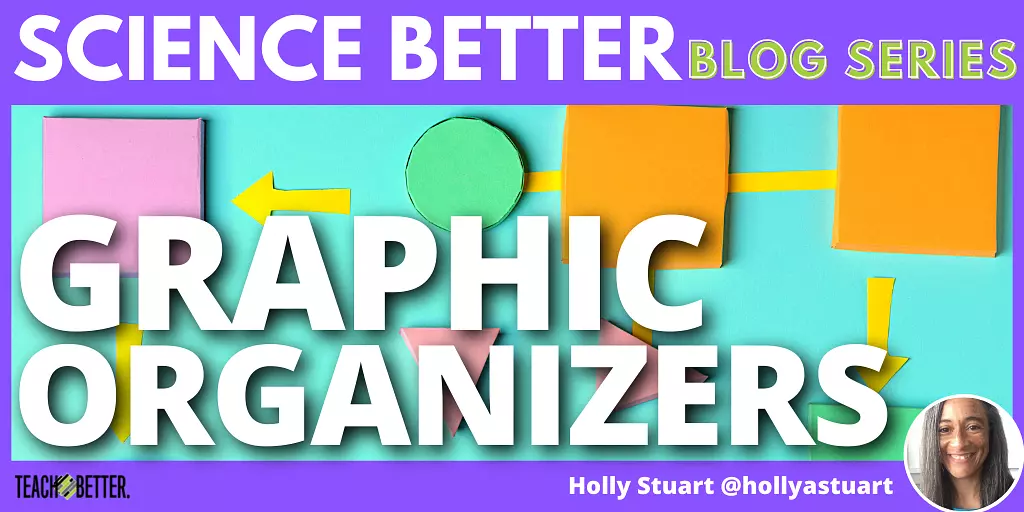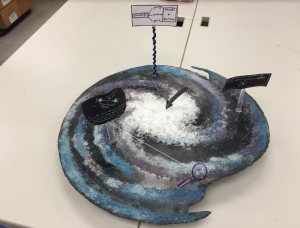TL;DR:
- Graphic organizers can increase creativity and can serve as a mastery checkpoint.
- Graphic organizers can increase understanding of complicated concepts and are fun to make!
I love using graphic organizers in my classroom. The structure and organization provided by a well-crafted graphic organizer can make complicated concepts appear simple. This is important when teaching about science topics that can seem overwhelming to middle schoolers. Also, I really enjoy making graphic organizers. I go beyond just boxes and lines; I get creative with shapes, colors, and designs so that each one ties to the content. This blog will show you a few of my favorite graphic organizers I have created and used over the years.
The structure and organization provided by a well-crafted graphic organizer can make complicated concepts appear simple. Click To TweetNewton’s Laws
For this assignment, students write about motion in their everyday lives and connect it to one or more of Newton’s Laws. However, before they start writing, I make sure that they have a clear understanding of Newton’s Three Laws of Motion by using a graphic organizer. I chose a different color for each law. The color scheme is consistent with every learning opportunity we had done in class up to this point.
Then, I determined what I needed my students to do to show their knowledge of Newton’s Laws. I came up with four things: the alternate name, the definition, a diagram, and a real-world example. I created four different shapes to represent each of the concepts and put the organizer together. When students complete this step, the writing becomes much easier and less intimidating. And I usually get some pretty good paragraphs, including work from the students that struggle with writing.
My Epoch Vacation
During our Earth’s Systems and Resources Unit, students write a travel blog from the perspective of a tectonic plate. I like this assignment because it allows my students to showcase their creativity in their science class. Again, I check for understanding before the writing process begins with a graphic organizer. The concepts that students must understand for this assignment are plate boundaries (and hotspots), geologic activity at each boundary, and landform changes at each boundary.
Due to the creative nature of this writing assignment, I add in a section for my students to brainstorm the thoughts, feelings, and emotions that the tectonic plate would experience as it bumps into another plate (convergent boundary), glides over a hotspot, etc. Color is used to categorize the different plate boundaries on the graphic organizer and the different boxes indicate where the information should go. I have found that students will often go back to their graphic organizer and add in more descriptive words as they are writing. Because it is fun and different, their creative juices really get flowing! Student work submitted for this assignment ranges from diary-style entries to graphic novels with illustrations and comic strips.
A Spacewalk Through 8th Grade Science
This project is used as an end-of-the-year science content review. Students choose any space object (planet, exoplanet, star, galaxy, etc.) and make a model of it. On the model, they have to provide factual information about their object AND show how their object connects to two other units that we covered throughout the year. The graphic organizer for this assignment utilizes a lot of circles connected to each other. The intent is to provide a visual reminder to my students about the various systems in space and the connectivity of the science content.
[scroll down to keep reading]Again, the purpose of the graphic organizer is to place information about their object in the center with the connections to the prior units “orbiting” around it. The two-unit connections are on opposite sides of the graphic organizer so that students won’t get them mixed up. Intentional use of the graphic organizer before students begin the model-making process ensures that my students have all of the information that they need to include in their model. It is up to them to use their creativity to show the connection in the model. Some students write it as an essay, while others incorporate it into the model itself (see image below).
I hope that this has helped some of you to think differently about what a graphic organizer “should” look like and encouraged you to start creating some new and interesting graphic organizers for your classroom instruction. If you have some graphic organizer templates that you have used in the past or create some new ones, please share them with me. And please reach out if you ever want to have a conversation about graphic organizers. After all, if we have more tools in our tool belts, then we can all Science Better.
About Holly Stuart
Holly Stuart is an 8th grade science and design teacher in South Carolina. Her educational passions include finding new and innovative ways to get more students interested in STEAM, student-inspired discovery through inquiry, and learning science by doing science.
In addition to her out-of-the-box thinking in the classroom, she has successfully implemented The Grid Method into her teaching practice which led to her becoming a Teach Better Team Ambassador. Holly is married to her high school sweetheart and is a mother to three children.
When not teaching, she enjoys traveling and being outside with her family. Some of their favorite outdoor activities include hiking, running, and biking. (Holly often brings her telescope, binoculars, and microscopes with her on hikes!) Her indoor hobbies include reading, coloring, and learning more about sketchnoting and drawing.






